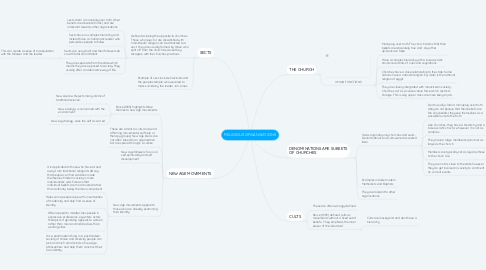
1. THE CHURCH
1.1. 4 MAIN FUNCTIONS
1.1.1. Monopoly over truth. The church claims that their beliefs are absolutely true and any other opinions are false
1.1.2. Have a complex hierarchy with a bureaucratic structure and lots of rules and regulations.
1.1.3. Churches have a close relationship to the state. Some nations have a national religion. Eg. Islam is the national religion of egypt
1.1.4. They are closely integrated with mainstream society. Churches act as a conservative force which restricts change. This is why upper class are more likely to join.
2. SECTS
2.1. Defined as being the opposite to churches. Those who reject or are dissatisfied with mainstream religion can be attracted to a sect. they are usually formed by those who split off from the church because they disagree with the churches practices.
2.1.1. sects claim a monopoly over truth. (their beliefs are absolute truths) and are intolerant towards other organisations
2.1.2. Sects have no complex hierarchy and instead have a charismatic leader who persuades people to follow
2.1.3. Sects are very small and their followers do so with total commitment.
2.1.3.1. This can create a sense of manipulation with the follower and the leader
2.1.4. They are separate from the state which means they are opposed to society. They usually offer an alternative way of life.
2.2. Example of secs include Calvinists and the peoples temple who were led to mass suicide by the leader Jim Jones
3. DENOMINATIONS ARE SUBSETS OF CHURCHES
3.1. It was originally only churches and sects, Denominations and cults were discovered later
3.1.1. Don't usually claim a monopoly over truth (they do not believe that their beliefs are the only beliefs) they see themselves as a possible route to the truth
3.1.2. Like churches, they have a hierarchy and a bureaucratic structure however it is not as complex
3.1.3. They have a large membership but not as large as the church
3.1.4. Members are typically not as loyal as those to the chuch are
3.1.5. They are not as close to the state however they do get involved in society to comment on current events.
3.2. Examples include modern Methodists and Baptists
3.3. They are tolerant to other organisations
4. CULTS
4.1. These are often wrongly defined
4.2. Bruce (1995) defined cults as movements without a fixed set of beliefs. They emphasis the inner power of the individual.
4.2.1. Cults are loosely knit and dont have a hierarchy
5. NEW AGE MOVEMENTS
5.1. Bruce(1995) highlights three themes to new age movements
5.1.1. New science- Rejects many claims of traditional science.
5.1.2. New ecology- is concerned with the environment
5.1.3. New psychology- sees the self as sacred
5.2. These are similar to cults and world affirming movements( self help or therapy groups) New age ideas are not often linked to an organisation but are spread through a culture
5.3. New Age followers focus on self-spirituality and self development
5.4. New age movements appeal to those who are already examining their identity
5.4.1. It is applicable to those who have turned away from traditional religion. NAB say that people can find salvation inside themselves. Modern society is more individualistic which means that individual beliefs are more trusted rather than authority being the main component
5.4.2. Helps some people cope with uncertainties of modernity and help find a sense of identity
5.4.3. Often appeal to middle class people in expressive professions. eg writers actors therapists. It generally appeals to women rather than men and middle class than working class
5.4.4. It is a postmodern thing. In a postmodern society of choice and diversity people can pick and mix from all kinds of new age philosophers and help them construct their own identity.

